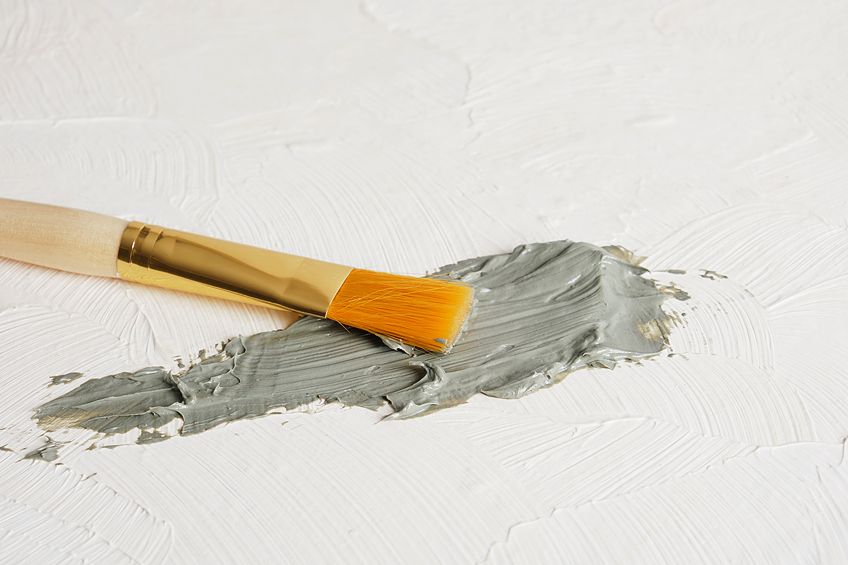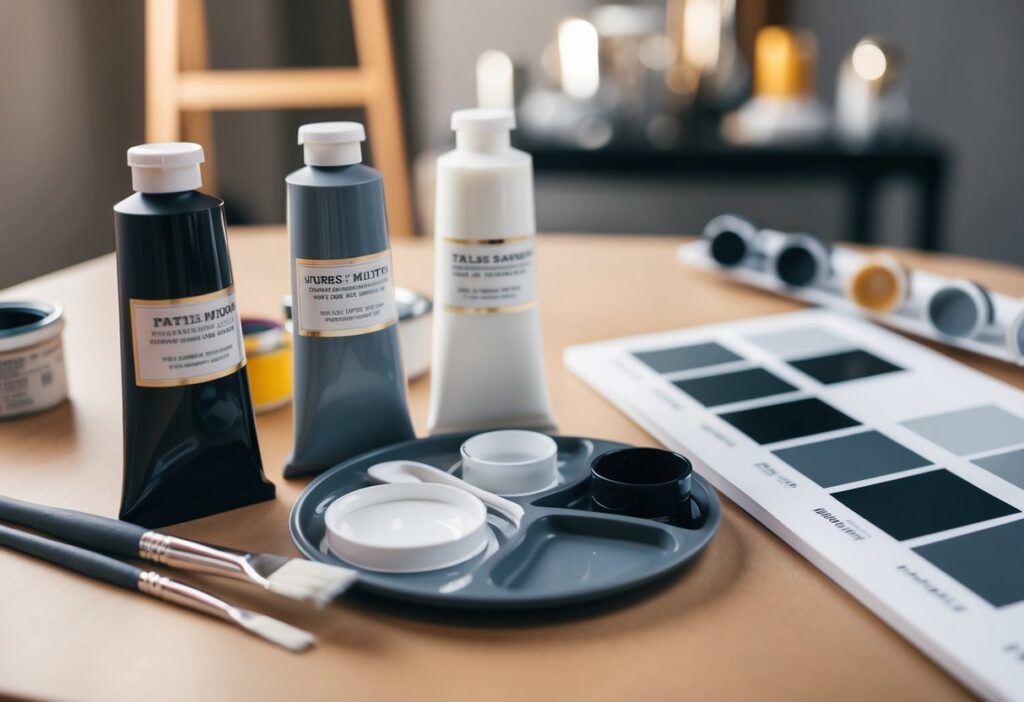How To Make Gray Paint: Simple Tips for Perfect Shades
Making gray paint at home is easier than you might think. Instead of heading to the store, you can mix your own right in your living room. To make gray paint, combine equal parts of black and white paint. It’s as simple as that! Need a shade darker? Add more black paint. Want something lighter? Bring in more white.

But what if you want something other than the basic gray? That’s where the fun of color theory comes in. You can create more exciting grays by mixing primary colors like red, blue, and yellow. It’s fascinating how these primary colors can blend to create soft and warm gray hues.
Ready to get creative? Grab your mixing brushes and gather your colors. Imagine being able to say, “I made this color!” With a few simple steps, you can develop new shades and nuances that give life and depth to your art projects. Who said making gray had to be boring?
Understanding Color Theory
When you think about mixing colors, do you picture a color wheel spinning in your mind? Color theory helps you use this wheel to mix primary colors and create different shades. It’s your guide for making stunning color schemes or even a neutral color like gray.

The Basics of Color Mixing
Color mixing is a fun way to play with paints. Thanks to the color wheel, you get to mix primary colors—red, yellow, and blue—to create a rainbow of new shades. Mixing these in different combinations gives you secondary colors like green and purple.
Serious about making gray? Mix black and white or try mixing complementary colors like orange and blue. These methods create various shades of gray. You might even come up with your very own warm gray or cool gray by experimenting with these mixes!
Shades, Tints, and Undertones
Ever notice how one gray can look different from another? That’s because of shades, tints, and undertones. Darken or lighten gray by adding black or white, creating a unique tint.
Undertones add personality; a hint of blue can make it a cool gray, while red can give you a warm gray. When choosing a gray for your next painting project, consider these undertones to match your desired color scheme. Play around and see how subtle tinting can change everything!
Crafting the Perfect Gray Paint
Creating the perfect gray paint involves understanding how different colors combine and how small adjustments can lead to a wide range of shades. You will learn the basics of mixing gray, incorporating complementary colors, and achieving various shades of gray paint.
Mixing Basic Gray
To create a basic neutral gray, all you need are black and white paints. Here’s a simple way: start by mixing equal parts black and white. This will give you a mid-tone gray. If you want lighter gray, add more white; for a darker tone, mix in extra black.
Use a small container to mix and keep track of your ratios. It’s a good idea to note down your mix ratios, especially if you need the same shade again. By adjusting the amounts, you can easily make custom gray paint that suits your needs.
Incorporating Complementary Colors
Sometimes, you might want a gray that leans a bit toward another color – warm or cool. Blend complementary colors to create warm or cool gray tones. For instance:
- Red and Green: Mix to get a neutral gray.
- Blue and Orange: Combine for a cool gray.
- Yellow and Purple: Use to make a warm gray.
Adding a touch of these complementary colors gives the gray paint subtle undertones, making it unique. It’s a creative way to use colors to make gray, especially when you want more than just a simple black and white combination.

Achieving Different Shades
With gray paint, you have countless possibilities. Consider these options:
- Light Gray: Add lots of white.
- Dark Gray: Increase black content.
- Pastel Gray: Add just a hint of color, like a soft pink or blue, alongside white.
You can experiment with amounts to get the shade you desire. Making custom gray paint gives you more control over your project. Adjusting the balance between light and dark tones, plus adding complementary colors, allows for endless shades of gray. The best part? You can personalize your space with just a few simple steps!
Adjusting Gray Paint for Warmth and Coolness
Not all grays are the same! You can make gray paint warmer or cooler by adding different colors. This lets you get creative and give your gray paint a unique feel that fits any room or project.
Creating Warm Grays
To make a warm gray, you’ll want to add colors that have a warm tone. Think about using shades like cadmium orange or alizarin crimson. These colors add a cozy feel to your gray paint. Mix them in gradually.
Start by adding small amounts. If you add too much, you can always lighten with white. A little can go a long way. Warm grays often pair nicely with natural materials like wood.
Looking to create a medium warm gray? Mix equal parts of black and white to get a base gray, then carefully add your warm colors. It’s like adding a splash of sunshine to your space.
Creating Cool Grays
For a cool gray, try colors like ultramarine blue. This cool tone adds a fresh and modern twist to your gray paint. Cool grays are perfect for creating an airy and calm vibe.
To get this look, mix your base gray first. Combine black and white in equal parts. Then, start adding a touch of your cool color. Remember to stir well, and test as you go.
If you want a lighter cool gray, just add a bit more white. Think of it as giving your gray a hint of sky blue. Cool grays work great in spaces that need an open and relaxed atmosphere.
Practical Applications and Tips

Gray paint is versatile and neutral, making it a favorite choice for interior design and art projects. You’ll find it helps create consistency in style and is convenient for color matching.
Interior Design and Gray Paint
Gray paint fits well into many design schemes. As a neutral shade, it pairs wonderfully with bright colors, offering versatility in room decoration. Color matching is a breeze, too. Picture a soft gray wall paired with vibrant yellow ochre decor. This creates a warm and inviting glow.
Consistency in gray tones can be achieved through the use of ultramarine or naphthol crimson pigments. These can adjust warmth or coolness as needed. Curious about a cool ambiance? A touch of blue can give your gray the perfect feel.
Mixing Gray Paint for Art
Artists love gray for its adaptability in color palettes. Mixing gray involves balancing pigments to get the desired tone. When creating gray paint, painting techniques matter. Start with a base of white and slowly add black or other pigments like ultramarine for cooler tones or yellow ochre for warmth.
Gray helps in building depth in artworks. It can be a background color for paintings or part of the subject. Using neutral gray can make other colors stand out. Try different pigment mixes to find your favorite shade for future projects.
Maintaining Consistency in Gray Paint
Keeping the consistency of your gray paint just right can feel tricky. Want a smooth finish? Begin by ensuring your base colors are mixed thoroughly. Use a consistent ratio of black and white every time to achieve the desired shade. Check the paint mix frequently to keep the texture even.
Use a color mixing guide to track your steps, noting down the amounts you mix. This helps you remember what ratio you used for the exact shade of gray you loved. It’s like having a paint recipe that you can rely on again and again!
If you find that your paint dries unevenly, try adding a few drops of water or a paint conditioner. These can help maintain a smoother texture. Remember how you love it when your dessert is just the right texture? Gray paint is kind of the same way!
For fine adjustments, use small amounts. Try color matching by comparing it to the gray shades in the room under good lighting. This lets you see how close you are to your ideal gray.
Mix small test batches before committing to large amounts. Paint a small area first to see how it dries. Testing can prevent surprises later. You wouldn’t want half a wall in a different hue, right?
Advanced Color Mixing
Diving into advanced color mixing lets you create stunning shades of gray. By exploring complex grays and using tinting and shading techniques, you can control the mood of your artwork.

Exploring Complex Grays
Creating complex grays can elevate your artwork to new heights. Instead of just mixing black and white, try blending complementary colors like red and green or blue and orange. These combinations yield rich, neutral grays with added depth.
You can also try mixing Cadmium Red with Phthalo Green. This method results in a darker, more intense gray. Adjusting the ratio will fine-tune the gray tone, so don’t shy away from experimentation. The beauty of complex grays is their versatility; they can be both warm and cool. You can modify the color temperatures slightly with extra pigment.
Tinting and Shading Techniques
To create different light grays and dark grays, you need to master tinting and shading. Tinting involves adding white to your gray mix. This technique lightens the color, perfect for creating lighter tones. Imagine the soft gray of early morning fog!
On the flip side, shading adds black or even Burnt Umber to your color mix. This will deepen your gray, adding a sense of mystery or drama. Aim for several shades by preparing different mixtures with varied amounts of black or Burnt Umber. Small adjustments can make big differences, so take time to test and explore how these changes impact your overall piece.
Frequently Asked Questions
Mixing gray paint can be fun and rewarding. You’ll learn about combining colors, adjusting shades, and creating unique tones.
What two colors can be combined to create grey paint?
You can mix black and white paint to make gray. Start with equal parts for a neutral shade. It’s the easiest way to get that perfect gray without fuss.
How do I mix paint to get a light grey shade?
If you want a lighter gray, use more white paint than black. Add the black paint a little at a time. You’ll see the shade get lighter as you add more white.
Can grey paint be achieved without using black or white, and if so, how?
Yes, it’s possible! Combine red, blue, and yellow. These primary colors can mix to make a gray tone. Experiment by adjusting the amounts for the perfect gray.
What’s the secret to darkening grey paint once it’s mixed?
To make your gray paint darker, gradually mix in small amounts of black paint. Add a little at a time and mix well until you reach your desired darkness.
Which color mixtures result in a gray with a hint of blue?
To achieve a gray with a blue tint, mix in a tiny amount of blue paint with your gray. Gradually add more blue until the shade meets your preference. Test as you go!
Is there a specific chart or guide for mixing different shades of grey paint?
Many charts and guides are available. These resources often illustrate how different amounts of black, white, or other colors create new shades. Check online or DIY stores!
